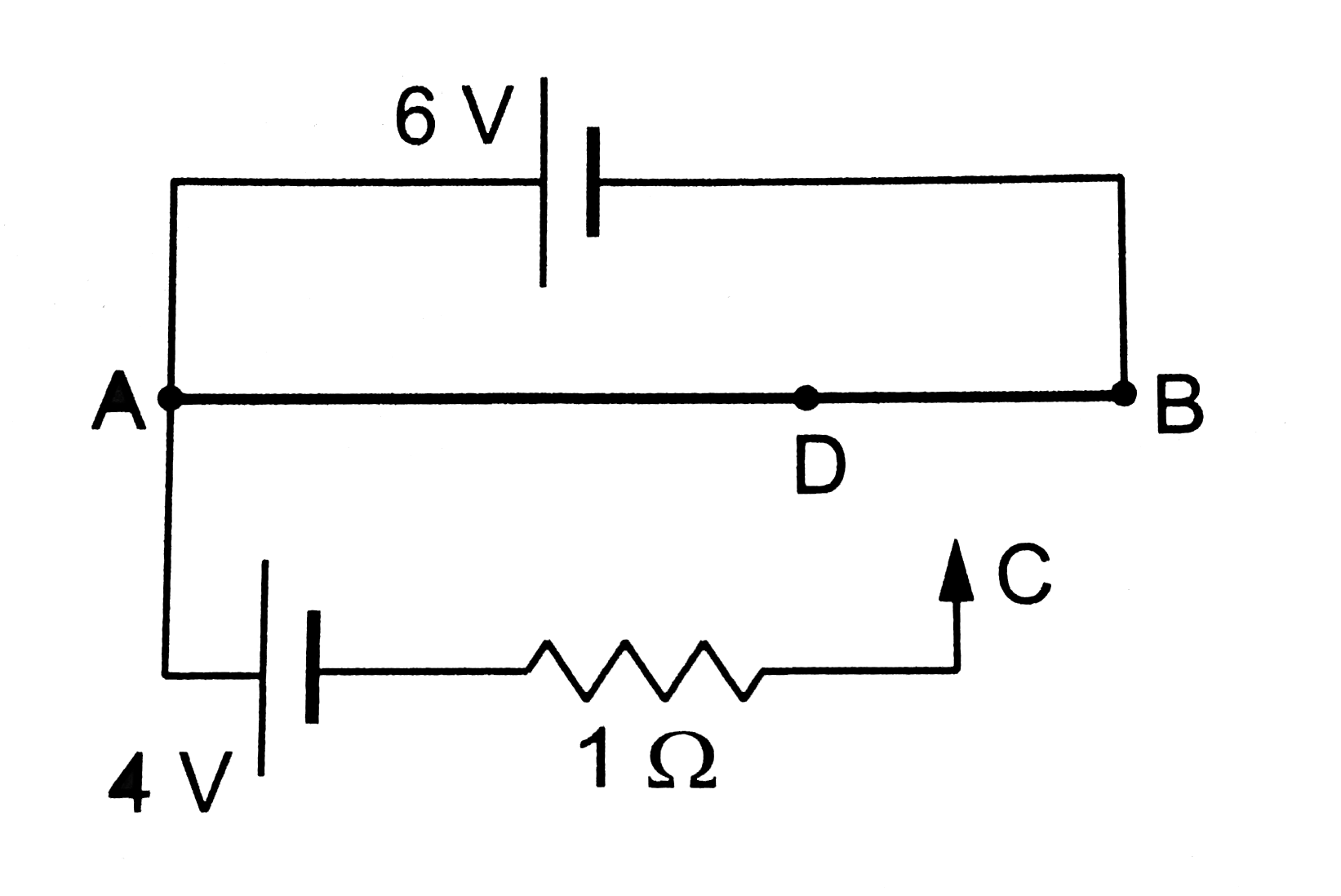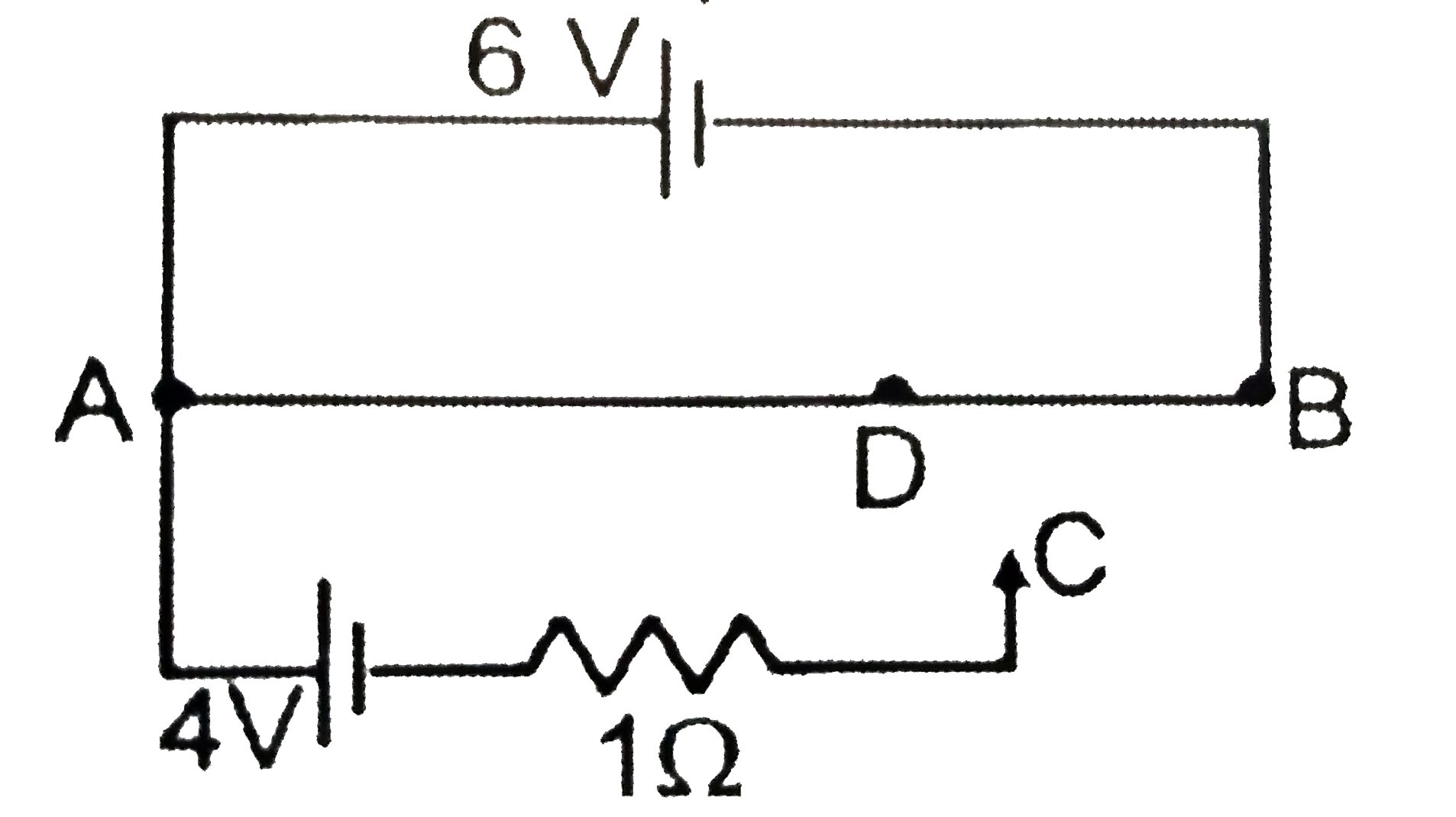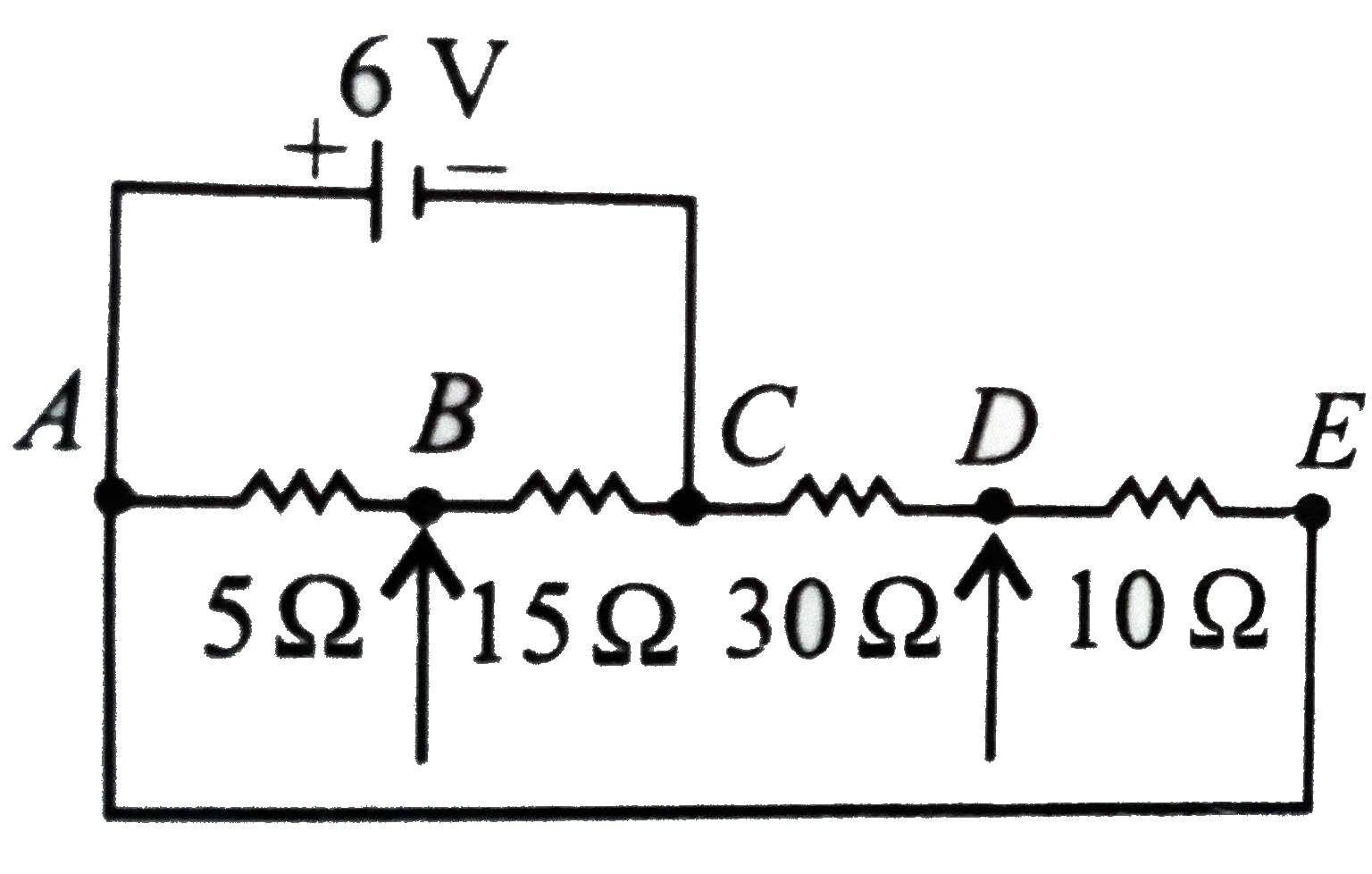A 6-volt battery of negligible internal resistance is connected across a uniform wire AB of length 100cm. The positive terminal of another battery of emf 4V and internal resistance 1(Ω)is joined to the point A as shown in figure.Take the potential at B to be zero. (a) What are the potentials at the poits A and C ? (b) At which point D of the wire AB, the potential is equal to the potential at C?(c ) If the point C and D are connected by a wire, what will be the current through it ? (d) If the 4V battery is replaced by 7.5V battery,wht would be the answer of parts (a) and (b) ?
 Solution in Gujrati
Solution in Gujrati
Potential difference between AB is 6V. B
is at 0 potential. Thus potential of a point
is 6V.
The potential difference between AC is 4V.
VA−VC=4
VC=VA−4=6−4=2V.
(b) The potential difference at D =2V=VAD=4V.
VBD=0V
Current through the resisters R_1 & R_2 are
equal. Thus ,
4R1=2R2
⇒R1R2=2
⇒l1l2=2
(Acc.to the law of potentiometer)
⇒l1+l2=100cm
⇒l1+(l12)=100cm
⇒3l12=100cm
⇒=l1=2003cm=66.67cm.
AD=66.67cm
(c)When the points C and D are connected
by a wire, current flowing through it is 0,
since the points are equipotential .
(d) Potential at A = 6V.
PotentialatC=6−7.5=−1.5V.
The potential at B= 0 and towards A
potential increases. Thus negative
potential point does not come within the
wire.
Topper's Solved these Questions
- ELECTRIC CURRENT IN CONDUCTORSBOOK - HC VERMACHAPTER - ELECTRIC CURRENT IN CONDUCTORSEXERCISE - Objective 2
9 Videos
- DISPERSION AND SPECTRABOOK - HC VERMACHAPTER - DISPERSION AND SPECTRAEXERCISE - Exercises
11 Videos
- ELECTRIC CURRENT THROUGH GASESBOOK - HC VERMACHAPTER - ELECTRIC CURRENT THROUGH GASESEXERCISE - Exercises
23 Videos
Similar Questions
Electrons are emitted by a hot filament and are accelerated by an electric field as shown in figure .The two stops at the left ensure that the electron beam has a uniform cross-section.

View SolutionA flint glass prism and a crown glass prism are to be combined in such a way that the deviation of the mean ray is zero. The refractive index of flint and crown glasses for the mean ray are 1.620 and 1.518 respectively. If the refracting angle of the flint prism is 6.0∘, what would be the refracting angle of the crown prism ?
View SolutionA discharge tube contains helium at a low pressure. A large potential difference is applied across the tube. Consider a helium atom that has just been ionized due to the detachment of an atomic electron. Find the ratio of the distance travelled by the free electron to that by the positive ion in a short time dt after the ionization.
View SolutionA 6-volt battery of negligible internal resistance is connected across a uniform wire AB of length 100cm. The positive terminal of another battery of emf 4V and internal resistance 1(Ω)is joined to the point A as shown in figure.Take the potential at B to be zero. (a) What are the potentials at the poits A and C ? (b) At which point D of the wire AB, the potential is equal to the potential at C?(c ) If the point C and D are connected by a wire, what will be the current through it ? (d) If the 4V battery is replaced by 7.5V battery,wht would be the answer of parts (a) and (b) ?

View SolutionA 6 volt battery of negligible internal resistance is connected across a uniform wire AB of length 100cm. The positive terminal of another battery of emf 4V and internal resistance 1Ω is joind to the point A as shown in figure. Take the potential at B to be zero. (a) What are the potentials at the points A and C ? (b) At which D of the wire AB, the potential is equal to the potential at C. ( c) If the point C and D are connected by a wire. What will be the current through is ? (d) Id the 4V batteryt is replaced by 7.5 V battery, what whould be the answers of parts (a) and (b) ?

View SolutionA 6V battery of negligible internal resistance is connected across a uniform wire of length 1m . The positive terminal of another battery of emf 4V and internal resistance 1Omega is joined to the point A as shown in figure. The ammeter shows zero deflection when the jockey touches the wire at the point C . The AC is equal to
View SolutionA potentiometer wire has length 10m and resistance 10Ω. It is connected to battery of EMF 11 volt and internal resistance 1Ω, then the potential gradient in the wire is
View SolutionA 6V battery of negligible internal resistance is connected across a uniform wire AB of length 100cm. The positive terminal of another battery of emf 4V and internal resistance 1Omega is joined to the point A as shown in figure. Take the potential at B to be zero. 2What are the potentials at points A and C ?
View SolutionA 6 volt battery of negligible internal resistance is connected across a uniform wire AB of length 100cm. The positive terminal of another battery of emf 4V and internal resistance 1Ω is joind to the point A as shown in figure. Take the potential at B to be zero. (a) What are the potentials at the points A and C ? (b) At which D of the wire AB, the potential is equal to the potential at C. ( c) If the point C and D are connected by a wire. What will be the current through is ? (d) Id the 4V batteryt is replaced by 7.5 V battery, what whould be the answers of parts (a) and (b) ?

View SolutionA 6V battery of internal resistance 1 Omega is connected across a uniform wire AB of length 100 cm. The positive terminal of another battery of E.M.F 4V and internal resistance 1 Omega is joined to the point A as shown. The distance of point P from A is alpha xx 10 cm . Find the value of alpha , for which there is no current through the galvanometer. (resistance of AB wire is 5 Omega )
View SolutionA 6V battery of negligible internal resistance is connected across a uniform wire of length 1m . The positive terminal of another battery of emf 4V and internal resistance 1Omega is joined to the point A as shown in figure . The ammenter shows zero deflection when the jockey touches the wire at the point C. The AC is equal to
View SolutionA 6-volt battery of negligible internal resistance is connected across a uniform wire AB of length 100cm. The positive terminal of another battery of emf 4V and internal resistance 1(Ω)is joined to the point A as shown in figure.Take the potential at B to be zero. (a) What are the potentials at the poits A and C ? (b) At which point D of the wire AB, the potential is equal to the potential at C?(c ) If the point C and D are connected by a wire, what will be the current through it ? (d) If the 4V battery is replaced by 7.5V battery,wht would be the answer of parts (a) and (b) ?

View SolutionPassage :
A 6V battery of negligible internal resistance is connected across a uniform resistive wire AB of length 100cm. The positive terminal of another battery of emf 4V and internal resistance 1Ω is joined to the point A as shown in figure. Take the potential at B to be zero.

What are the potentials at points A and C, C is not touching the wire AB
View SolutionPassage : A 6V battery of negligible internal resistance is connected across a uniform resistive wire AB of length 100cm. The positive terminal of another battery of emf 4V and internal resistance 1 Omega is joined to the point A as shown in figure. Take the potential at B to be zero. At which point D of the wire AB, the potential is equal to the potential at C, C is not touching the wire AB
View SolutionA 6 volt battery of internal resistance 1Ω is connected across a uniform wire AB of length 100 cm. The positive terminal of another battery of emf 4V and internal resistance 1Ω is joined to the point A as shown. Find the distance of point D from A is potential of C is equal to potential of D.(resistance of AB = 5Ω)

View SolutionFour resistors are connected as shown in the figure. A 6 V battery of negligible resistance is connected across terminal battery of negligible resistance A and C. The potential difference across terminal B and D will be

View Solution
